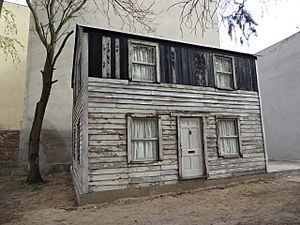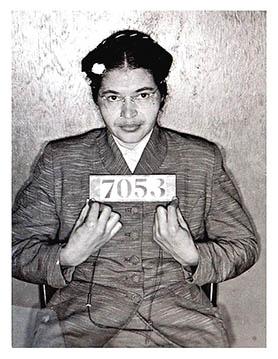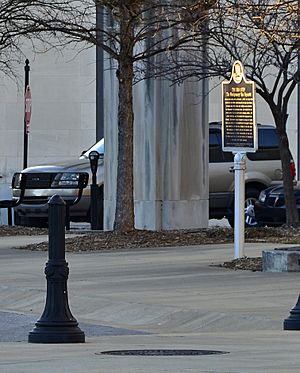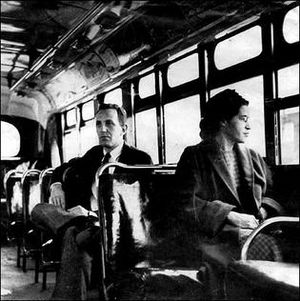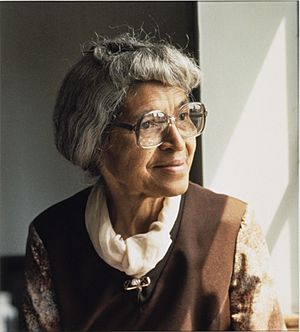Rosa Parks facts for kids
Quick facts for kids
Rosa Parks
|
|
|---|---|
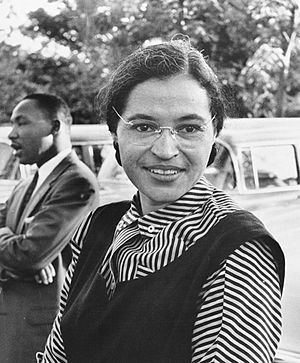
Rosa Parks in 1955, with Martin Luther King Jr. in the background
|
|
| Born |
Rosa Louise McCauley
February 4, 1913 |
| Died | October 24, 2005 (aged 92) |
| Resting place | Woodlawn Cemetery, Detroit, Michigan, U.S. |
| Occupation | Civil rights activist |
| Known for | Montgomery bus boycott |
| Movement | Civil Rights Movement |
| Spouse(s) |
Raymond Parks
(m. 1932; died 1977) |
| Signature | |
Rosa Louise McCauley Parks (born February 4, 1913 – died October 24, 2005) was an African-American activist who worked for civil rights. She is often called "the mother of the modern-day American civil rights movement." She was a member of a local group called the National Association for the Advancement of Colored People (NAACP).
Rosa Parks is famous for something she did in her hometown of Montgomery, Alabama, on December 1, 1955. She was sitting on a bus in a section meant for Black people. The bus driver told her to give up her seat so a white passenger could sit there. At that time, if seats for white people were full, Black people were forced to give up their seats. Rosa Parks bravely said no. Like many others, she was tired of being treated unfairly because of her skin color.
Rosa was arrested for refusing to move. This event led to the Montgomery Bus Boycott. This was a huge protest where Black people refused to ride the city buses. The boycott lasted for 381 days. It helped change the law, making it illegal to separate people by race on buses. Her refusal to be treated differently became a very important symbol in the fight against racial segregation (keeping people apart because of their race).
Contents
Early Life of Rosa Parks
Rosa Parks was born in Tuskegee, Alabama, on February 4, 1913. Her parents were James and Leona McCauley. Most of her family came from Africa.
Rosa's father left home to find work when she was two years old. Her mother was a teacher in another town. Rosa and her brother Sylvester were raised by their grandparents.
Rosa started school in 1919 when she was six. Back then, schools were segregated. This meant there were separate schools for Black children and white children. Rosa later remembered how white students rode buses to their school, but Black students had to walk:
I'd see the bus pass every day... But to me, that was a way of life; we had no choice but to accept what was the custom. The bus was among the first ways I realized there was a black world and a white world.
In 1924, she went to the Montgomery Industrial School for Girls. After five years, she left school to work in a shirt factory. She also helped care for her grandmother.
In 1932, Rosa married Raymond Parks, who was a barber. Rosa worked many different jobs. Her husband encouraged her to finish high school, which she did in 1933.
The Bus Ride and Her Brave Choice
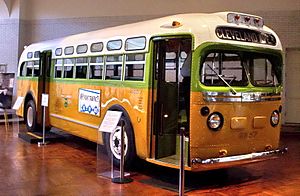
On December 1, 1955, Rosa Parks got on a city bus to go home after work. She paid her fare and sat in the first row of seats behind the section reserved for white passengers. As the bus continued, more white passengers got on and filled the front seats. The bus driver told Rosa Parks and three other Black people to give up their seats for the white passengers. The other three people moved, but Rosa Parks slid closer to the window. She felt she was already sitting in the correct section.
The driver stopped the bus and called the police. Two police officers arrested Rosa Parks. She was taken to jail for breaking Alabama's bus laws.
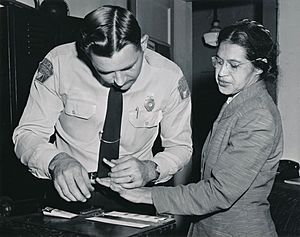
Her mother called Edgar Nixon to help. Nixon was the leader of the local NAACP group. Rosa was a member and worked as Nixon's secretary. Nixon knew Rosa was in danger and quickly arranged for her to be released from jail.
The local NAACP had been looking for a way to challenge the unfair bus laws in court. Rosa Parks was a respected working woman. She was well-spoken, and her case was seen as a good way to fight the law. It was decided that on December 5, the day Rosa was supposed to go to court, a boycott of all Montgomery buses would happen.
The Montgomery Bus Boycott
News of the bus boycott spread quickly through the Black community. Black ministers told their church members to support the boycott. On Monday, December 5th, Rosa Parks went to court, and Black passengers stayed off the Montgomery buses. The streets of Montgomery were filled with Black people walking. The buses stayed empty all day. White passengers also stayed off the buses.
Rosa Parks was found guilty of breaking the bus laws and was fined $14. But the boycott continued.
Browder v. Gayle and Victory
Rosa Parks's attorney, Fred Gray, and others from the NAACP took her case to a higher court. This case was called Browder v. Gayle. On June 19, 1956, the appeals court decided that the bus segregation laws were unfair. The city of Montgomery asked the Supreme Court to look at the decision again.
On September 13, 1956, the Supreme Court of the United States agreed with the appeals court. After 381 days, the bus boycott ended. Black citizens of Montgomery could now ride the buses and sit wherever they wanted. Rosa Parks rode the bus again on December 21, 1956. This time, it was an integrated bus, meaning people of all races could sit together. She even had the same bus driver who had her arrested the year before. Rosa Parks said in an interview, "He didn't react... and neither did I."
Life After the Boycott
After the Montgomery Bus Boycott, Rosa Parks faced many challenges. She lost her job at the department store. Her husband also had to quit his job.
In 1957, Rosa and her husband moved to Hampton, Virginia, to find work. Rosa found a job as a hostess at Hampton Institute, a college for Black students.
Later, Rosa Parks and her husband moved to Detroit, Michigan. Rosa continued to work as an activist. For many years, she worked for United States Congressman John Conyers. After that, she worked against apartheid (a system of racial separation) in South Africa. She also opened a center in Detroit that helped Black young people learn about careers and job opportunities.
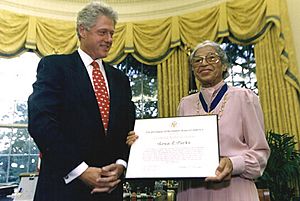
In 1999, President Bill Clinton gave Rosa Parks a Congressional Gold Medal. This is one of the highest honors a civilian (someone not in the military) can receive in the United States.
Rosa and her husband Raymond never had children. They spent their lives dedicated to each other and to fighting for civil rights.
Rosa Parks died on October 24, 2005, at her home in Detroit. She was 92 years old. On October 30, her casket was placed in the United States Capitol building for people to honor her. This is a very special honor in the United States.
Rosa Parks is still seen as a hero of the Black community. Her brave actions helped start big changes for fairness and equality.
Rosa Parks Quotes
- “You must never be fearful about what you are doing when it is right.”
- “Each person must live their life as a model for others.”
- “I knew someone had to take the first step and I made up my mind not to move.”
- “Differences of race, nationality, or religion should not be used to deny any human being citizenship rights or privileges.”
- "I believe there is only one race – the human race."
- "The only tired I was, was tired of giving in."
Interesting Facts about Rosa Parks
- Rosa earned her high school diploma at a time when very few African Americans did.
- Rosa Parks was working for civil rights 12 years before she refused to give up her seat on the bus.
- The bus driver, James F. Blake, had actually driven away without her on purpose 12 years before this famous event.
- Rosa Parks was not the first person to refuse to give up her seat on a Montgomery bus. A 15-year-old girl named Claudette Colvin was arrested for it first. Rosa Parks helped raise money for Claudette's legal defense.
- Rosa Parks was not physically tired when she refused to give up her seat. She explained that she was "tired of giving in" to unfair rules.
- Rosa Parks became the secretary of the NAACP group in Alabama.
- Bus seats were left empty in New York City, Washington, D.C., and other cities on the 50th anniversary of Rosa's arrest to honor her.
Questions Kids Ask about Rosa Parks
What is Rosa Parks famous for? When she refused to give her bus seat to a white man, she helped start the Civil Rights Movement in the United States.
How is Rosa Parks a hero? She was brave to peacefully refuse to leave her seat. She knew it wasn't right to have to give up her seat, but she also knew she would probably be arrested.
What was Rosa Parks's job? Rosa Parks worked as a seamstress (someone who sews clothes). She worked at the Montgomery Fair department store and was going home from there on the day she was arrested.
Why did Rosa Parks not give up her seat? She was tired of having to give up a seat for which she had paid. She believed she shouldn't have to move just because of her race.
Where is Rosa Parks buried? Woodlawn Cemetery (Detroit, Michigan), United States.
What did the Montgomery bus boycott lead to? The boycott led to the Supreme Court saying that Montgomery's segregation laws on buses were against the law.
What is Rosa Parks's full name? Rosa Louise McCauley Parks.
Who did Rosa Parks marry? Rosa married Raymond Parks, a barber, in 1932.
Images for kids
-
Rosa Parks statue by Eugene Daub (2013), in National Statuary Hall, United States Capitol
-
The Rosa Parks Congressional Gold Medal
-
Parks and U.S. President Bill Clinton
-
Rosa Parks Railway Station in Paris
See also
 In Spanish: Rosa Parks para niños
In Spanish: Rosa Parks para niños


